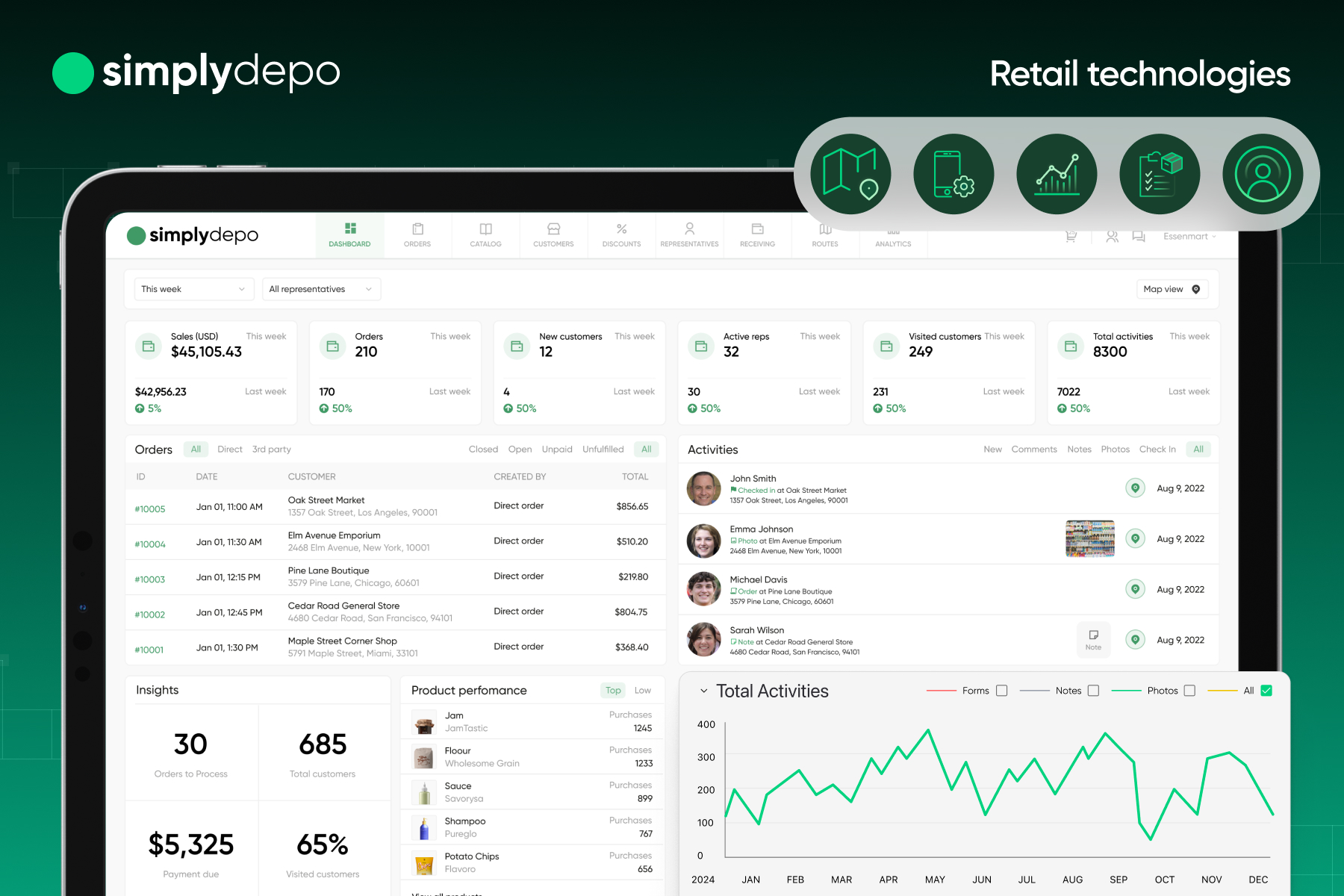Retail is no longer just about stocking shelves and ringing up sales. In 2025, retail technology is the backbone of success for both brick-and-mortar and B2B businesses. From intelligent inventory systems to real-time analytics and mobile execution tools, the tech you choose will make or break your business.
But with hundreds of tools out there, how do you know what’s worth your investment?
Let’s break down the must-have technologies in today’s retail landscape—and how they can drive efficiency, growth, and customer satisfaction.
The New Retail Reality: Why Technology Matters
Retail is more competitive than ever. Consumer expectations are evolving, supply chains are more complex, and the pressure to optimise margins is relentless.
Retailers who invest in the right technology can:
- Automate manual tasks
- Reduce costs
- Improve on-shelf availability
- Deliver faster, more personalised experiences
The stakes are high: brands face an increasingly global market, shifting customer preferences, and the challenge of delivering personalized experiences at scale. Here are some emerging trends reshaping the industry:
- AI-Powered Demand Forecasting: With machine learning and predictive analytics, retailers are gaining deeper insights into consumer behavior, enabling better demand forecasting.
- Automation in Customer Service: Chatbots, AI-based recommendation systems, and self-checkout kiosks are revolutionizing customer service.
- Sustainability and Tech: As consumers demand more sustainable practices, technology helps retailers optimize their supply chains to reduce waste and carbon footprints.
These trends underline how critical it is for businesses to stay up-to-date with technology, offering more than just operational efficiency but a competitive edge that helps improve customer loyalty and retention.
According to McKinsey, retailers that fully integrate digital tools can improve EBIT margins by 3–5% through smarter operations and data-driven decision-making.
1. Retail Execution Software: Real-Time Store Visibility
For CPG brands and wholesale distributors, retail execution is where strategy meets reality. You may have a great product and perfect planograms, but without visibility into what’s happening in stores, things fall apart.
Key features to look for:
- Mobile apps for field reps
- Image recognition for shelf checks
- Task tracking and compliance monitoring
- Offline capabilities for remote store visits
✅ Why It Matters:
Retail execution tools ensure your products are present, priced correctly, and promoted according to plan. You get instant feedback from the field and can act on it quickly.
💡 SimplyDepo, a mobile-first retail execution solution, helped ICalm boost field visit productivity by 30% demonstrating the immediate value of leveraging real-time insights to prevent out-of-stock issues and optimize in-store presence.. Read the case study →
2. Inventory Management Software: No More Stockouts or Overstock
Inaccurate inventory kills profit.
With fragmented supply chains and increased demand variability, inventory visibility is key. The right tech can:
- Predict demand with smart forecasting
- Reduce dead stock
- Simplify replenishment processes
- Connect warehouse, sales, and delivery> In a SimplyDepo success story, HC Foods reduced its warehouse stockouts by 40% in just three months using demand planning and automated reorder triggers.
✅ Why It Matters:
Managing inventory across multiple distribution channels—especially in wholesale—requires synchronisation and real-time data. Manual spreadsheets just can’t keep up.
💡 Procter & Gamble (P&G), one of the largest CPG companies in the world, has implemented an integrated inventory management system across its supply chain. Using advanced forecasting and replenishment systems, P&G is able to accurately predict demand for products in various regions, reduce excess inventory, and minimize stockouts. For example, P&G used demand sensing and predictive analytics to optimize the distribution of their Tide brand, ensuring that retailers received the right amount of stock at the right time. This has not only reduced excess inventory costs but also improved product availability on store shelves, leading to stronger relationships with both retailers and consumers.
3. Route Optimisation Tools: Smarter Sales and Delivery
For businesses with field sales teams or delivery fleets, route optimisation technology is a game-changer. It minimises travel time, reduces fuel costs, and ensures your reps hit more stops per day.
Features that drive results:
- Drag-and-drop route planning
- Traffic prediction and GPS integration
- Sales history filters to prioritise clients
- Territory and workload balancing
SimplyDepo’s route management helped Brickyard Brands cut down their delivery time per route by 25%, while increasing weekly client visits by 18%.
4. Retail Analytics Platforms: Turning Data Into Action
You can’t improve what you don’t measure. Retail analytics tools collect and visualise data across all operations—sales, stock, staff performance, promotions—so you can make better decisions.
Powerful analytics tools offer:
- Real-time dashboards
- Sales and trend analysis
- Customer behaviour insights
- Store-by-store or SKU-by-SKU breakdowns
✅ Why It Matters:
With granular data, you can refine your assortment, reallocate budgets and even predict future performance—before it affects your bottom line.
5. CRM and Order Management Tools: Centralising Communication and Sales
Wholesale brands need more than just e-commerce platforms—they need tools that manage B2B relationships, track orders, and streamline reordering.
Look for:
- Multi-channel order capture
- Reorder automation
- Customer-specific pricing and catalogues
- Integration with ERP and logistics
SimplyDepo brings together retail execution, inventory, and order management in one unified platform—reducing tool fragmentation and giving your team full visibility into the customer lifecycle.
How to Choose the Right Retail Technology Stack
Here’s a framework to guide your decisions: CriteriaWhat to ConsiderBusiness Model FitDoes it support B2B, B2C, or hybrid? Ease of UseIs the UI intuitive for field reps and managers? Scalability supports your growth over the next 3–5 years? Integration it connects with your existing systems (ERP, CRM, logistics)? Support & Customization, there reliable onboarding, training, and localization?
SimplyDepo: One Platform, Total Visibility
If you’re managing retail distribution, field teams, and wholesale growth, SimplyDepo offers an all-in-one platform that simplifies execution and unlocks growth.
With SimplyDepo, you get:
- A mobile app for field sales and merchandising teams
- Route and task management
- Inventory and stock visibility
- Wholesale order capture and account management
💬 “We’re not just placing orders anymore. We’re making decisions based on real-time data from every store we visit.” — Brickyard Brands Team
In this retail technology showdown, there’s no winner. The most successful businesses combine tools across execution, inventory, and analytics to create a responsive, data-driven business.
It’s not about buying more tools—it’s about investing in the right tools that work together.
FAQ:
What is retail technology?
Retail technology refers to digital tools and software that help manage, automate, and optimise various retail operations, including sales, inventory, customer engagement, and fulfillment.
What’s the best retail technology for small distributors?
Look for lightweight, mobile-first platforms that combine retail execution and order management, like SimplyDepo.
Can small businesses afford advanced retail technology?
Yes! With mobile-first, lightweight solutions like SimplyDepo, small businesses can access enterprise-grade features without breaking the bank. These tools offer scalability and flexibility, enabling businesses of all sizes to optimize their operations, improve customer satisfaction, and reduce costs.
How can retail technology help my wholesale business?
It streamlines orders, reduces manual errors, helps you track field activity, and gives you visibility into what’s happening at the store level.
How much should I budget for retail technology?
Budgets vary depending on the size of your business, but the best ROI often comes from tools that replace multiple systems and reduce inefficiencies across the board.
What’s the ROI on retail technology investment?
The return on investment (ROI) from retail technology comes from streamlining operations, reducing inefficiencies, and improving customer experiences. Retailers that implement the right tools can see improvements in margins by 3–5%, according to McKinsey, as well as better demand forecasting, reduced stockouts, and optimized delivery routes.


Boost Sales.
Cut Manual Work.
Streamline ordering, routing, and retail execution — while giving every rep the tools to grow accounts faster.
Book a Demo
Save weekly
per rep
Increase
buyer retention
Increase
in retail sales
Error: Contact form not found.















![How to Choose the Right Distribution Strategy in Retail? [2026 Guide]](https://simplydepo.com/wp-content/uploads/2025/11/426.jpg)